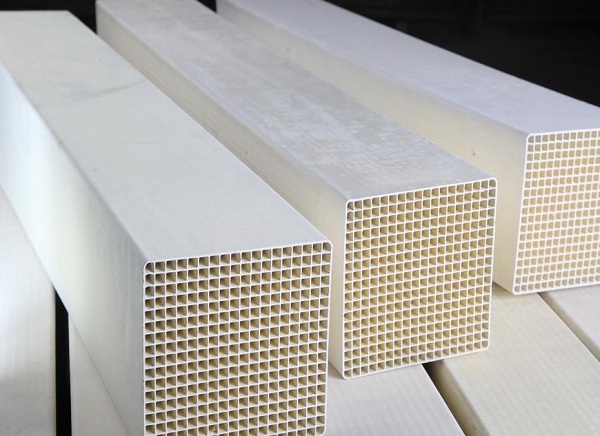Regeneration and Application Analysis of Denitration Catalysts
Publishdate:2019-04-23 Views:87
The application of denitration catalysts in process production is quite common. Understanding the design life and initial performance, operating time and conditions of failed catalysts, understanding the specific reasons for catalyst failure, and conducting advanced physical and mechanochemical test box analysis on catalyst test blocks. Through EDX/XRF/SEM/TGA/BET analysis, the deactivation degree of failed SCR catalysts is determined.

Pre treatment of deactivated SCR catalyst
1. Send the module to be processed into the automatic cleaning tank, spray it with high-pressure water automatically, and then enter the manual cleaning tank for the second manual cleaning to remove clogged ash in the catalyst channels.
2. After automatic spraying and manual clear module identification, the subsequent process is determined based on whether the catalyst monomer in the catalyst module is renewable.
3. The regeneration and utilization of deactivated SCR denitrification catalysts mainly consist of the following steps: pre cleaning - regeneration analysis - deep cleaning - addition of active materials - drying.
2、 Recycling
1. Deep cleaning of renewable utilization modules is carried out using a dedicated cleaning solution. The clogged ash is removed from the waste catalyst module through the use of surfactants, emulsifiers, chelating agents, and other components in the dedicated cleaning solution. This part of the ash combines with the effective components in the cleaning agent to form a precipitate, which is discharged with the cleaning wastewater and then manually cleaned again to completely remove the clogged ash on the catalyst surface.
2. Ultrasonic cleaning is used to deeply clean the pores of discarded catalysts.
3. Acid cleaning requires the catalyst to maintain a fixed acid position during operation in the denitrification system in order to better react with nitrogen dioxide. However, during use, the catalyst may be poisoned by alkali metals such as potassium and sodium. Therefore, acid cleaning is necessary to completely remove alkaline substances from the catalyst pores and ensure that the catalyst's acid position meets the activity requirements.
4. After deep cleaning, the catalyst cleaning module can completely remove impurities such as clogging. Adjust the activity of the catalyst module by adding vanadium oxalate solution to meet the requirements of the SCR denitrification system. Then enter the drying room, control the drying temperature at 70 ℃, and remove the moisture carried out by the cleaning process in the form of water vapor.
The application of denitration catalysts in process production is quite common. Understanding the design life and initial performance, operating time and conditions of failed catalysts, understanding the specific reasons for catalyst failure, and conducting advanced physical and mechanochemical test box analysis on catalyst test blocks. Through EDX/XRF/SEM/TGA/BET analysis, the deactivation degree of failed SCR catalysts is determined.

Pre treatment of deactivated SCR catalyst
1. Send the module to be processed into the automatic cleaning tank, spray it with high-pressure water automatically, and then enter the manual cleaning tank for the second manual cleaning to remove clogged ash in the catalyst channels.
2. After automatic spraying and manual clear module identification, the subsequent process is determined based on whether the catalyst monomer in the catalyst module is renewable.
3. The regeneration and utilization of deactivated SCR denitrification catalysts mainly consist of the following steps: pre cleaning - regeneration analysis - deep cleaning - addition of active materials - drying.
2、 Recycling
1. Deep cleaning of renewable utilization modules is carried out using a dedicated cleaning solution. The clogged ash is removed from the waste catalyst module through the use of surfactants, emulsifiers, chelating agents, and other components in the dedicated cleaning solution. This part of the ash combines with the effective components in the cleaning agent to form a precipitate, which is discharged with the cleaning wastewater and then manually cleaned again to completely remove the clogged ash on the catalyst surface.
2. Ultrasonic cleaning is used to deeply clean the pores of discarded catalysts.
3. Acid cleaning requires the catalyst to maintain a fixed acid position during operation in the denitrification system in order to better react with nitrogen dioxide. However, during use, the catalyst may be poisoned by alkali metals such as potassium and sodium. Therefore, acid cleaning is necessary to completely remove alkaline substances from the catalyst pores and ensure that the catalyst's acid position meets the activity requirements.
4. After deep cleaning, the catalyst cleaning module can completely remove impurities such as clogging. Adjust the activity of the catalyst module by adding vanadium oxalate solution to meet the requirements of the SCR denitrification system. Then enter the drying room, control the drying temperature at 70 ℃, and remove the moisture carried out by the cleaning process in the form of water vapor.




